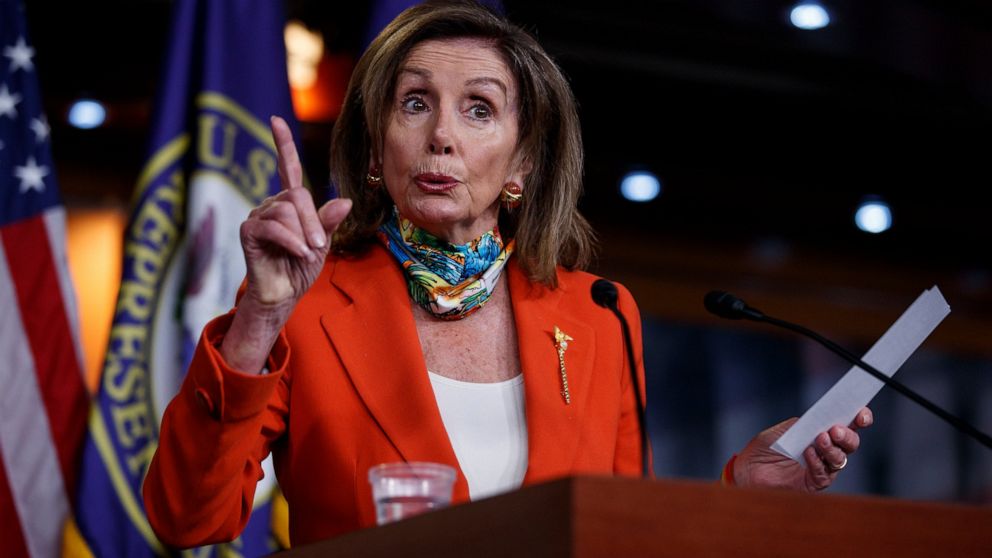Dem climate plan would end greenhouse gas emissions by 2050
House Democrats have unveiled a plan to address climate change that would set a goal of net-zero greenhouse gas emissions by 2050
By
MATTHEW DALY Associated Press
June 30, 2020, 3:45 PM
4 min read
4 min read
WASHINGTON — House Democrats have unveiled a plan to address climate change that would set a goal of net-zero greenhouse gas emissions by 2050, while pushing renewable energy such as wind and solar power and addressing environmental injustice that harms low-income and minority communities.
The plan, put forth Tuesday in a 538-page report, sets a range of targets, including a 45% reduction by 2030 of the greenhouse gas emissions that cause global warming. The plan also would require that new cars sold by 2035 emit no greenhouse gases, while heavy-duty trucks would eliminate those emissions by 2040. The plan would eliminate overall emissions from the power sector by 2040 and all but eliminate greenhouse emissions from all economic sectors by 2050.
The plan backed by House Speaker Nancy Pelosi and other leaders is less ambitious than a sweeping Green New Deal that a group of progressive Democrats outlined last year to transform the U.S. economy to combat climate change and create thousands of jobs in renewable energy. The Green New Deal, championed by Rep. Alexandria Ocasio-Cortez, D-N.Y., calls for dramatic steps to virtually eliminate U.S. greenhouse gas emissions by 2030 and sets a goal to meet “100% of the power demand in the United States through clean, renewable and zero-emission energy sources,” including nuclear power.
The new proposal offers a similar sweep but at a slower pace.
Supporters say the plan, presented by Democrats on the House Select Committee on the Climate Crisis, would save more than 60,000 American lives every year by 2050 thanks to reduced air pollution, as well as nearly $8 trillion saved through 2050 thanks to health and climate benefits.
“Democrats know the climate crisis is the essential crisis of our time, threatening public health, jobs and the economy, national security and values,” Pelosi said Tuesday at a Capitol news conference.
“We are here today to provide hope and vision,” said Rep. Kathy Castor, D-Fla., chairwoman of the climate panel. She called the Democratic plan a “transformative road map for solving the climate crisis,” and pledged that it would address environmental justice and vulnerable communities that are suffering from the effects of air and water pollution and industrial waste.
“The health of our families and the air we breathe are at the heart of our plan,” Castor said, adding that the plan would create good-paying jobs in solar and wind energy, manufacturing electric vehicles and ensuring that communities are more resilient to flooding, extreme heat, intense hurricanes and wildfires.
The Democratic plan received immediate support from more than 90 outside organizations, including major environmental groups and leaders in environmental justice, agriculture, public health and transportation.
In a sign of the changed political environment, the Democratic plan heavily emphasizes environmental justice and notes that the report’s release comes as the nation is reeling from a cascade of crises, including the COVID-19 pandemic. which has killed more than 120,000 Americans; stay-at-home orders and business closures that have put 40 million Americans out of work; and nationwide protests in response to the police killing of an unarmed Black man, George Floyd.
Throughout these crises, President Donald Trump has “failed to lead the country in a unified and compassionate response, instead choosing to fan the flames of discord and distrust,” the report said.
Even with all of these problems, the climate crisis stands out, Democrats said.
“We cannot wait” to solve the problem, the report said, noting that atmospheric carbon dioxide concentrations in May 2020 exceeded the highest monthly average ever recorded. Last month tied for the highest global May temperature in 141 years of record-keeping.
“As the earth continues to heat up, climate-related impacts, including heat waves, extreme storms, droughts and flooding, are worsening,” the report said. “The country’s most vulnerable populations — low-income communities and communities of color that have been hardest hit by the COVID-19 pandemic — are most at risk, as underlying demographic, socioeconomic and health factors act as threat multipliers for the dangerous impacts of climate change.”
While the costs of inaction continue to rise, “the solutions to climate change — including building and rebuilding America’s energy, transportation, and manufacturing infrastructure to be cleaner and more resilient to climate impacts — offer an opportunity to propel the economy forward,” the report said.
![]()


